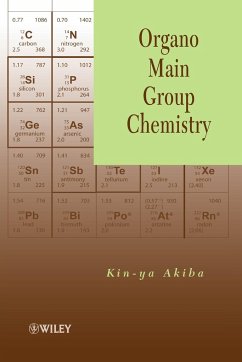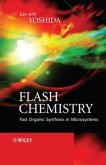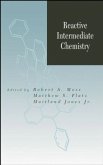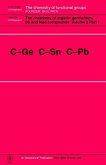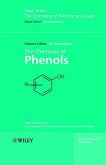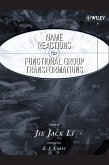Kin-ya Akiba
Organo Main Group Chemistry
Kin-ya Akiba
Organo Main Group Chemistry
- Broschiertes Buch
- Merkliste
- Auf die Merkliste
- Bewerten Bewerten
- Teilen
- Produkt teilen
- Produkterinnerung
- Produkterinnerung
This vital resource book captures the essential scope of organic chemistry of all main group elements and covers all main group elements dealing with syntheses and reactions of their organic compounds. While organic compounds of second row elements centered at carbon are the major components of animals and plants, those of the third row and below are also important and have unique roles which this book discusses. Since main group chemistry has been traditionally classified as a part of inorganic chemistry, this book establishes the scope of organic chemistry of main group elements.
Andere Kunden interessierten sich auch für
![The Chemistry of Free Radicals The Chemistry of Free Radicals]() Zeev B. Alfassi (Hrsg.)The Chemistry of Free Radicals1.032,99 €
Zeev B. Alfassi (Hrsg.)The Chemistry of Free Radicals1.032,99 €![Flash Chemistry Flash Chemistry]() Jun-Ichi YoshidaFlash Chemistry225,99 €
Jun-Ichi YoshidaFlash Chemistry225,99 €![Reactive Intermediate Chemistry Reactive Intermediate Chemistry]() Reactive Intermediate Chemistry220,99 €
Reactive Intermediate Chemistry220,99 €![S-Centered Radicals S-Centered Radicals]() Zeev B. Alfassi (Hrsg.)S-Centered Radicals694,99 €
Zeev B. Alfassi (Hrsg.)S-Centered Radicals694,99 €![The Chemistry of Organic Germanium, Tin and Lead Compounds, 2 Volume Set The Chemistry of Organic Germanium, Tin and Lead Compounds, 2 Volume Set]() Zvi Rappoport (Hrsg.)The Chemistry of Organic Germanium, Tin and Lead Compounds, 2 Volume Set3.418,99 €
Zvi Rappoport (Hrsg.)The Chemistry of Organic Germanium, Tin and Lead Compounds, 2 Volume Set3.418,99 €![The Chemistry of Phenols, 2 Volume Set The Chemistry of Phenols, 2 Volume Set]() Zvi Rappoport (Hrsg.)The Chemistry of Phenols, 2 Volume Set2.677,99 €
Zvi Rappoport (Hrsg.)The Chemistry of Phenols, 2 Volume Set2.677,99 €![Name Reactions of Functional Group Transformations Name Reactions of Functional Group Transformations]() Jie Jack LiName Reactions of Functional Group Transformations240,99 €
Jie Jack LiName Reactions of Functional Group Transformations240,99 €-
-
This vital resource book captures the essential scope of organic chemistry of all main group elements and covers all main group elements dealing with syntheses and reactions of their organic compounds. While organic compounds of second row elements centered at carbon are the major components of animals and plants, those of the third row and below are also important and have unique roles which this book discusses. Since main group chemistry has been traditionally classified as a part of inorganic chemistry, this book establishes the scope of organic chemistry of main group elements.
Hinweis: Dieser Artikel kann nur an eine deutsche Lieferadresse ausgeliefert werden.
Hinweis: Dieser Artikel kann nur an eine deutsche Lieferadresse ausgeliefert werden.
Produktdetails
- Produktdetails
- Verlag: Wiley & Sons
- Artikelnr. des Verlages: 14545033000
- 1. Auflage
- Seitenzahl: 288
- Erscheinungstermin: 23. August 2011
- Englisch
- Abmessung: 234mm x 156mm x 16mm
- Gewicht: 413g
- ISBN-13: 9780470450338
- ISBN-10: 0470450339
- Artikelnr.: 33237021
- Herstellerkennzeichnung
- Libri GmbH
- Europaallee 1
- 36244 Bad Hersfeld
- gpsr@libri.de
- Verlag: Wiley & Sons
- Artikelnr. des Verlages: 14545033000
- 1. Auflage
- Seitenzahl: 288
- Erscheinungstermin: 23. August 2011
- Englisch
- Abmessung: 234mm x 156mm x 16mm
- Gewicht: 413g
- ISBN-13: 9780470450338
- ISBN-10: 0470450339
- Artikelnr.: 33237021
- Herstellerkennzeichnung
- Libri GmbH
- Europaallee 1
- 36244 Bad Hersfeld
- gpsr@libri.de
KIN-YA AKIBA, PHD, is a Professor Emeritus in the Department of Chemistry at Hiroshima University and a visiting researcher at the Advanced Research Institute for Science and Engineering at Waseda University. Among his many honors are the 1996 Humboldt Research Award, the 1997 Award by the Chemical Society of Japan, and the 2000 Medal with Purple Ribbon by the Prime Minister of Japan.
Preface ix 1 Main Group Elements and Heteroatoms: Scope and Characteristics 1 1.1 Aufbau Principle and Sign of Orbitals / 1 1.2 Electronic Configuration of an Atom: Main Group Elements and Heteroatoms / 3 1.3 Fundamental Properties of Main Group Elements / 5 1.4 Acidity of Carboxylic Acid and Substituent Effect / 7 1.5 Heteroatom Effect / 10 1.5.1 Stabilization of
-Carbocation by Resonance: Stereoelectronic Effect / 10 1.5.2 Coordination with Lewis Acids / 15 References / 16 Notes 1: Electronegativity 17 Notes 2: Importance of Formal Logic-I: Oxidation Number and Formal Charge 19 Notes 3: Importance of Formal Logic-II: Octet Rule, Eighteen-Electron Rule, Hypervalence 23 2 Main Group Element Effect 25 2.1 What Is Main Group Element Effect? / 25 2.2 Single Bond Energy and
-Bond Energy / 27 2.3 Hypervalent Compound / 31 2.4 Effect of Hypervalent Bond (1): 3c-4e Bond and Structure / 33 2.5 Effect of Hypervalent Bond (2): Apicophilicity and Pseudorotation / 41 2.6 Effect of Hypervalent Bond (3): Ligand Coupling Reaction (LCR) and Edge Inversion / 45 2.7 Effect of
X
C / 46 2.8 Effect of
X
C / 48 Notes 4: (
,
) and (
,
): HMO (Hueckel Molecular Orbital) and Electrocyclic Reaction 57 3 Lithium, Magnesium, and Copper Compounds 63 3.1 Synthesis / 64 3.2 Structure / 66 3.3 Reaction / 68 3.3.1 Deprotonation as Base / 69 3.3.2 Nucleophilic Reaction / 72 3.3.3 Conjugate Addition of Lithium Dimethylcuprate / 76 References / 77 4 Boron and Aluminum Compounds 79 4.1 Synthesis / 80 4.2 Structure / 82 4.3 Reaction / 84 References / 88 5 Silicon, Tin, and Lead Compounds 91 5.1 Synthesis / 92 5.2 Reaction / 94 5.3 Organotin and Lead Compounds / 100 References / 104 Notes 5: Stable Carbene and Its Complex 105 6 Phosphorus, Antimony, and Bismuth Compounds 111 6.1 Phosphorus Compounds / 112 6.2 Synthesis of Organophosphorus Compounds / 113 6.3 Tertiary Phosphine and Its Nucleophilic Reaction / 115 6.4 Arbuzov Reaction / 117 6.5 Perkow Reaction / 118 6.6 Synthesis of Optically Active Phosphines / 119 6.7 Ylide and Wittig Reaction and Related Ones / 123 6.8 Reactions of Phosphonium Salts and Formation of Phosphoranes / 131 6.9 Freezing BPR and Its Effect / 138 6.10 Antimony and Bismuth Compounds / 143 References / 146 Notes 6: Dreams of Staudinger and Wittig 149 Notes 7: Stereochemistry in Nucleophilic Substitution of MX4-type Compounds: Inversion or Retention 155 7 Sulfur, Selenium, and Tellurium Compounds 159 7.1 Sulfur Compounds / 160 7.2 Synthesis of Organosulfur Compounds / 160 7.3 Reactions of Organosulfur Compounds / 166 7.4 Structure and Reaction of Hypervalent Organosulfur Compounds / 170 7.5 Selenium and Tellurium Compounds / 175 References / 178 Notes 8: Inversion Mechanism of NH3 and NF3: Vertex Inversion or Edge Inversion 181 8 Organohalogen Compounds: Fluorine and Iodine Compounds 187 8.1 Synthesis of Chlorine and Bromine Compounds / 188 8.2 Fluorine Compounds / 190 8.3 Iodine Compounds / 195 References / 199 9 Atrane and Transannular Interaction: Formation of Hypervalent Bond 201 9.1 Introduction / 201 9.2 Silatrane and Atrane / 202 9.3 Transannular Interaction (1) / 208 9.4 Transannular Interaction (2) / 210 References / 211 10 Unsaturated Compounds of Main Group Elements of Third Period and Heavier 213 10.1 Introduction / 213 10.2 Unsaturated Bonds of Group 15 Elements of Third Period and Heavier / 215 10.3 Unsaturated Bonds of Group 14 Elements of Third Period and Heavier / 219 10.4 Aromatic Compounds of Group 14 Elements / 222 References / 223 11 Ligand Coupling Reaction 225 11.1 Introduction / 225 11.2 Selectivity of Ligand Coupling Reaction: Theoretical Investigation / 226 11.3 Ligand Coupling Reaction of Organic Compounds of Phosphorus, Antimony, and Bismuth / 227 11.4 Ligand Coupling Reaction of Organic Compounds of Sulfur, Selenium, and Tellurium / 237 11.5 Ligand Coupling Reaction of Organoiodine Compounds / 241 References / 245 Notes 9: Hexavalent Organotellurium Compounds 247 12 Hypervalent Carbon Compounds: Can Hexavalent Carbon Exist? 251 12.1 Introduction / 251 12.2 Attempts for Pentacoordinate Hypervalent Carbon Species / 253 12.3 Synthesis of Pentacoordinate Hypervalent Carbon Species (10-C-5) and Bond Switching at Carbon and Boron / 254 12.4 Attempts to Hexacoordinate Hypervalent Carbon Species (12-C-6) / 259 References / 262 Notes 10: Main Group Element Porphyrins 265 Index 269
-Carbocation by Resonance: Stereoelectronic Effect / 10 1.5.2 Coordination with Lewis Acids / 15 References / 16 Notes 1: Electronegativity 17 Notes 2: Importance of Formal Logic-I: Oxidation Number and Formal Charge 19 Notes 3: Importance of Formal Logic-II: Octet Rule, Eighteen-Electron Rule, Hypervalence 23 2 Main Group Element Effect 25 2.1 What Is Main Group Element Effect? / 25 2.2 Single Bond Energy and
-Bond Energy / 27 2.3 Hypervalent Compound / 31 2.4 Effect of Hypervalent Bond (1): 3c-4e Bond and Structure / 33 2.5 Effect of Hypervalent Bond (2): Apicophilicity and Pseudorotation / 41 2.6 Effect of Hypervalent Bond (3): Ligand Coupling Reaction (LCR) and Edge Inversion / 45 2.7 Effect of
X
C / 46 2.8 Effect of
X
C / 48 Notes 4: (
,
) and (
,
): HMO (Hueckel Molecular Orbital) and Electrocyclic Reaction 57 3 Lithium, Magnesium, and Copper Compounds 63 3.1 Synthesis / 64 3.2 Structure / 66 3.3 Reaction / 68 3.3.1 Deprotonation as Base / 69 3.3.2 Nucleophilic Reaction / 72 3.3.3 Conjugate Addition of Lithium Dimethylcuprate / 76 References / 77 4 Boron and Aluminum Compounds 79 4.1 Synthesis / 80 4.2 Structure / 82 4.3 Reaction / 84 References / 88 5 Silicon, Tin, and Lead Compounds 91 5.1 Synthesis / 92 5.2 Reaction / 94 5.3 Organotin and Lead Compounds / 100 References / 104 Notes 5: Stable Carbene and Its Complex 105 6 Phosphorus, Antimony, and Bismuth Compounds 111 6.1 Phosphorus Compounds / 112 6.2 Synthesis of Organophosphorus Compounds / 113 6.3 Tertiary Phosphine and Its Nucleophilic Reaction / 115 6.4 Arbuzov Reaction / 117 6.5 Perkow Reaction / 118 6.6 Synthesis of Optically Active Phosphines / 119 6.7 Ylide and Wittig Reaction and Related Ones / 123 6.8 Reactions of Phosphonium Salts and Formation of Phosphoranes / 131 6.9 Freezing BPR and Its Effect / 138 6.10 Antimony and Bismuth Compounds / 143 References / 146 Notes 6: Dreams of Staudinger and Wittig 149 Notes 7: Stereochemistry in Nucleophilic Substitution of MX4-type Compounds: Inversion or Retention 155 7 Sulfur, Selenium, and Tellurium Compounds 159 7.1 Sulfur Compounds / 160 7.2 Synthesis of Organosulfur Compounds / 160 7.3 Reactions of Organosulfur Compounds / 166 7.4 Structure and Reaction of Hypervalent Organosulfur Compounds / 170 7.5 Selenium and Tellurium Compounds / 175 References / 178 Notes 8: Inversion Mechanism of NH3 and NF3: Vertex Inversion or Edge Inversion 181 8 Organohalogen Compounds: Fluorine and Iodine Compounds 187 8.1 Synthesis of Chlorine and Bromine Compounds / 188 8.2 Fluorine Compounds / 190 8.3 Iodine Compounds / 195 References / 199 9 Atrane and Transannular Interaction: Formation of Hypervalent Bond 201 9.1 Introduction / 201 9.2 Silatrane and Atrane / 202 9.3 Transannular Interaction (1) / 208 9.4 Transannular Interaction (2) / 210 References / 211 10 Unsaturated Compounds of Main Group Elements of Third Period and Heavier 213 10.1 Introduction / 213 10.2 Unsaturated Bonds of Group 15 Elements of Third Period and Heavier / 215 10.3 Unsaturated Bonds of Group 14 Elements of Third Period and Heavier / 219 10.4 Aromatic Compounds of Group 14 Elements / 222 References / 223 11 Ligand Coupling Reaction 225 11.1 Introduction / 225 11.2 Selectivity of Ligand Coupling Reaction: Theoretical Investigation / 226 11.3 Ligand Coupling Reaction of Organic Compounds of Phosphorus, Antimony, and Bismuth / 227 11.4 Ligand Coupling Reaction of Organic Compounds of Sulfur, Selenium, and Tellurium / 237 11.5 Ligand Coupling Reaction of Organoiodine Compounds / 241 References / 245 Notes 9: Hexavalent Organotellurium Compounds 247 12 Hypervalent Carbon Compounds: Can Hexavalent Carbon Exist? 251 12.1 Introduction / 251 12.2 Attempts for Pentacoordinate Hypervalent Carbon Species / 253 12.3 Synthesis of Pentacoordinate Hypervalent Carbon Species (10-C-5) and Bond Switching at Carbon and Boron / 254 12.4 Attempts to Hexacoordinate Hypervalent Carbon Species (12-C-6) / 259 References / 262 Notes 10: Main Group Element Porphyrins 265 Index 269
Preface ix 1 Main Group Elements and Heteroatoms: Scope and Characteristics 1 1.1 Aufbau Principle and Sign of Orbitals / 1 1.2 Electronic Configuration of an Atom: Main Group Elements and Heteroatoms / 3 1.3 Fundamental Properties of Main Group Elements / 5 1.4 Acidity of Carboxylic Acid and Substituent Effect / 7 1.5 Heteroatom Effect / 10 1.5.1 Stabilization of
-Carbocation by Resonance: Stereoelectronic Effect / 10 1.5.2 Coordination with Lewis Acids / 15 References / 16 Notes 1: Electronegativity 17 Notes 2: Importance of Formal Logic-I: Oxidation Number and Formal Charge 19 Notes 3: Importance of Formal Logic-II: Octet Rule, Eighteen-Electron Rule, Hypervalence 23 2 Main Group Element Effect 25 2.1 What Is Main Group Element Effect? / 25 2.2 Single Bond Energy and
-Bond Energy / 27 2.3 Hypervalent Compound / 31 2.4 Effect of Hypervalent Bond (1): 3c-4e Bond and Structure / 33 2.5 Effect of Hypervalent Bond (2): Apicophilicity and Pseudorotation / 41 2.6 Effect of Hypervalent Bond (3): Ligand Coupling Reaction (LCR) and Edge Inversion / 45 2.7 Effect of
X
C / 46 2.8 Effect of
X
C / 48 Notes 4: (
,
) and (
,
): HMO (Hueckel Molecular Orbital) and Electrocyclic Reaction 57 3 Lithium, Magnesium, and Copper Compounds 63 3.1 Synthesis / 64 3.2 Structure / 66 3.3 Reaction / 68 3.3.1 Deprotonation as Base / 69 3.3.2 Nucleophilic Reaction / 72 3.3.3 Conjugate Addition of Lithium Dimethylcuprate / 76 References / 77 4 Boron and Aluminum Compounds 79 4.1 Synthesis / 80 4.2 Structure / 82 4.3 Reaction / 84 References / 88 5 Silicon, Tin, and Lead Compounds 91 5.1 Synthesis / 92 5.2 Reaction / 94 5.3 Organotin and Lead Compounds / 100 References / 104 Notes 5: Stable Carbene and Its Complex 105 6 Phosphorus, Antimony, and Bismuth Compounds 111 6.1 Phosphorus Compounds / 112 6.2 Synthesis of Organophosphorus Compounds / 113 6.3 Tertiary Phosphine and Its Nucleophilic Reaction / 115 6.4 Arbuzov Reaction / 117 6.5 Perkow Reaction / 118 6.6 Synthesis of Optically Active Phosphines / 119 6.7 Ylide and Wittig Reaction and Related Ones / 123 6.8 Reactions of Phosphonium Salts and Formation of Phosphoranes / 131 6.9 Freezing BPR and Its Effect / 138 6.10 Antimony and Bismuth Compounds / 143 References / 146 Notes 6: Dreams of Staudinger and Wittig 149 Notes 7: Stereochemistry in Nucleophilic Substitution of MX4-type Compounds: Inversion or Retention 155 7 Sulfur, Selenium, and Tellurium Compounds 159 7.1 Sulfur Compounds / 160 7.2 Synthesis of Organosulfur Compounds / 160 7.3 Reactions of Organosulfur Compounds / 166 7.4 Structure and Reaction of Hypervalent Organosulfur Compounds / 170 7.5 Selenium and Tellurium Compounds / 175 References / 178 Notes 8: Inversion Mechanism of NH3 and NF3: Vertex Inversion or Edge Inversion 181 8 Organohalogen Compounds: Fluorine and Iodine Compounds 187 8.1 Synthesis of Chlorine and Bromine Compounds / 188 8.2 Fluorine Compounds / 190 8.3 Iodine Compounds / 195 References / 199 9 Atrane and Transannular Interaction: Formation of Hypervalent Bond 201 9.1 Introduction / 201 9.2 Silatrane and Atrane / 202 9.3 Transannular Interaction (1) / 208 9.4 Transannular Interaction (2) / 210 References / 211 10 Unsaturated Compounds of Main Group Elements of Third Period and Heavier 213 10.1 Introduction / 213 10.2 Unsaturated Bonds of Group 15 Elements of Third Period and Heavier / 215 10.3 Unsaturated Bonds of Group 14 Elements of Third Period and Heavier / 219 10.4 Aromatic Compounds of Group 14 Elements / 222 References / 223 11 Ligand Coupling Reaction 225 11.1 Introduction / 225 11.2 Selectivity of Ligand Coupling Reaction: Theoretical Investigation / 226 11.3 Ligand Coupling Reaction of Organic Compounds of Phosphorus, Antimony, and Bismuth / 227 11.4 Ligand Coupling Reaction of Organic Compounds of Sulfur, Selenium, and Tellurium / 237 11.5 Ligand Coupling Reaction of Organoiodine Compounds / 241 References / 245 Notes 9: Hexavalent Organotellurium Compounds 247 12 Hypervalent Carbon Compounds: Can Hexavalent Carbon Exist? 251 12.1 Introduction / 251 12.2 Attempts for Pentacoordinate Hypervalent Carbon Species / 253 12.3 Synthesis of Pentacoordinate Hypervalent Carbon Species (10-C-5) and Bond Switching at Carbon and Boron / 254 12.4 Attempts to Hexacoordinate Hypervalent Carbon Species (12-C-6) / 259 References / 262 Notes 10: Main Group Element Porphyrins 265 Index 269
-Carbocation by Resonance: Stereoelectronic Effect / 10 1.5.2 Coordination with Lewis Acids / 15 References / 16 Notes 1: Electronegativity 17 Notes 2: Importance of Formal Logic-I: Oxidation Number and Formal Charge 19 Notes 3: Importance of Formal Logic-II: Octet Rule, Eighteen-Electron Rule, Hypervalence 23 2 Main Group Element Effect 25 2.1 What Is Main Group Element Effect? / 25 2.2 Single Bond Energy and
-Bond Energy / 27 2.3 Hypervalent Compound / 31 2.4 Effect of Hypervalent Bond (1): 3c-4e Bond and Structure / 33 2.5 Effect of Hypervalent Bond (2): Apicophilicity and Pseudorotation / 41 2.6 Effect of Hypervalent Bond (3): Ligand Coupling Reaction (LCR) and Edge Inversion / 45 2.7 Effect of
X
C / 46 2.8 Effect of
X
C / 48 Notes 4: (
,
) and (
,
): HMO (Hueckel Molecular Orbital) and Electrocyclic Reaction 57 3 Lithium, Magnesium, and Copper Compounds 63 3.1 Synthesis / 64 3.2 Structure / 66 3.3 Reaction / 68 3.3.1 Deprotonation as Base / 69 3.3.2 Nucleophilic Reaction / 72 3.3.3 Conjugate Addition of Lithium Dimethylcuprate / 76 References / 77 4 Boron and Aluminum Compounds 79 4.1 Synthesis / 80 4.2 Structure / 82 4.3 Reaction / 84 References / 88 5 Silicon, Tin, and Lead Compounds 91 5.1 Synthesis / 92 5.2 Reaction / 94 5.3 Organotin and Lead Compounds / 100 References / 104 Notes 5: Stable Carbene and Its Complex 105 6 Phosphorus, Antimony, and Bismuth Compounds 111 6.1 Phosphorus Compounds / 112 6.2 Synthesis of Organophosphorus Compounds / 113 6.3 Tertiary Phosphine and Its Nucleophilic Reaction / 115 6.4 Arbuzov Reaction / 117 6.5 Perkow Reaction / 118 6.6 Synthesis of Optically Active Phosphines / 119 6.7 Ylide and Wittig Reaction and Related Ones / 123 6.8 Reactions of Phosphonium Salts and Formation of Phosphoranes / 131 6.9 Freezing BPR and Its Effect / 138 6.10 Antimony and Bismuth Compounds / 143 References / 146 Notes 6: Dreams of Staudinger and Wittig 149 Notes 7: Stereochemistry in Nucleophilic Substitution of MX4-type Compounds: Inversion or Retention 155 7 Sulfur, Selenium, and Tellurium Compounds 159 7.1 Sulfur Compounds / 160 7.2 Synthesis of Organosulfur Compounds / 160 7.3 Reactions of Organosulfur Compounds / 166 7.4 Structure and Reaction of Hypervalent Organosulfur Compounds / 170 7.5 Selenium and Tellurium Compounds / 175 References / 178 Notes 8: Inversion Mechanism of NH3 and NF3: Vertex Inversion or Edge Inversion 181 8 Organohalogen Compounds: Fluorine and Iodine Compounds 187 8.1 Synthesis of Chlorine and Bromine Compounds / 188 8.2 Fluorine Compounds / 190 8.3 Iodine Compounds / 195 References / 199 9 Atrane and Transannular Interaction: Formation of Hypervalent Bond 201 9.1 Introduction / 201 9.2 Silatrane and Atrane / 202 9.3 Transannular Interaction (1) / 208 9.4 Transannular Interaction (2) / 210 References / 211 10 Unsaturated Compounds of Main Group Elements of Third Period and Heavier 213 10.1 Introduction / 213 10.2 Unsaturated Bonds of Group 15 Elements of Third Period and Heavier / 215 10.3 Unsaturated Bonds of Group 14 Elements of Third Period and Heavier / 219 10.4 Aromatic Compounds of Group 14 Elements / 222 References / 223 11 Ligand Coupling Reaction 225 11.1 Introduction / 225 11.2 Selectivity of Ligand Coupling Reaction: Theoretical Investigation / 226 11.3 Ligand Coupling Reaction of Organic Compounds of Phosphorus, Antimony, and Bismuth / 227 11.4 Ligand Coupling Reaction of Organic Compounds of Sulfur, Selenium, and Tellurium / 237 11.5 Ligand Coupling Reaction of Organoiodine Compounds / 241 References / 245 Notes 9: Hexavalent Organotellurium Compounds 247 12 Hypervalent Carbon Compounds: Can Hexavalent Carbon Exist? 251 12.1 Introduction / 251 12.2 Attempts for Pentacoordinate Hypervalent Carbon Species / 253 12.3 Synthesis of Pentacoordinate Hypervalent Carbon Species (10-C-5) and Bond Switching at Carbon and Boron / 254 12.4 Attempts to Hexacoordinate Hypervalent Carbon Species (12-C-6) / 259 References / 262 Notes 10: Main Group Element Porphyrins 265 Index 269

